In this Article:
In this rifle caliber comparison, we are going to take a look at two cartridges that most might not think to compare. We will take an in depth look at the 338 Lapua vs 308 and hopefully come out on the other side with a better understanding of both.
To be honest, there are going to be very few times where you sit and wonder should you go with a .338 or .308 chambered rifle, at least in the hunting world. For long range precision shooting, perhaps the dilemma might arise for some. Still, we think it is incredibly interesting to look at two cartridges that might be more different than similar and discuss why this is so and which situations they are better suited for.
For us, there is never a time we think one cartridge is better than the other. For certain situations, sure, but there will always be some point where one bests the other. So for this article, we will take a look at several performance categories of these two cartridges. In doing so, we hope to differentiate what these cartridges are capable of and in what situations one would serve you better than the other.
A Brief History
.338 Lapua Magnum
The .338 Lapua Magnum is a very interesting cartridge to look at as it brings some pretty incredible performance specs. This cartridge is much younger when compared to the other cartridge we will look at, but it is interesting because it is sometimes seen as a replacement for the .308 Win in specific shooting applications.
The .338 Lapua Magnum (LM) was introduced to the market in the late 1980’s and was designed for a specific purpose; to provide snipers with a cartridge that could punch through barriers and body armor from an incredible distance. As you can imagine, this is a hard hitting cartridge with its .338 cal bullet. This cartridge can utilize 200+ grain bullet weights and send them downrange at speeds seen in lighter cartridges which means massive knockdown power. These bullet weights and speeds also resulted in rounds with excellent ballistic coefficients which gave the .338 LM excellent trajectories at long range.
With such performance characteristics, it did not take long for the general public to become interested in what this cartridge could do. Since its introduction, the .338LM has become popular in shooting circles, especially in long-range shooting. And we mean long, long-range shooting. Its range and power have also made it popular for big and dangerous game. You might not see it as much in North America, but the .338 LM is a pretty popular round for larger African game.
With interest in the .338 LM in civilian circles, there are more options for the cartridge than there once was, but you are still going to have more difficulty finding it when compared to other cartridges. The price of these rounds might also be a bit eye-opening for some.
.308 Winchester
There are a lot of obscure rounds that some avid hunters or marksmen might not have heard of, but we would be willing to bet a large sum of money that anyone you speak to who has owned and used a rifle has heard of or handled the .308 Winchester cartridge. It’s easily one of the most well-known cartridges in the world and is forever linked with American firearms. While there is a rich history of the .308, it is still a relevant cartridge today in the hunting world and target shooting.
The .308 Winchester was introduced in 1952 and soon after the casing was modified and adopted as the 7.62x51mm NATO round that saw action in Vietnam. The .308 has been utilized by military and police forces since its introduction though not as heavily in modern times. Besides combat and other tactical situations, the performance of the .308 Win was quickly recognized and utilized by civilian shooters; especially by those in the hunting community.
The .308 Win has been and still is one of the most effective short action cartridges for medium to larger game in North America. The .30 cal bullet, 150-180grain bullet weights along with the performance specs, which we will look at in great detail, all culminated in a hunting cartridge that could reach out to the limits of ethical shooting ranges while still delivering the power to make a clean harvest on game from whitetail to elk with everything in between.
With the longevity of the cartridge’s popularity, though it might not be as prevalent as it once was, there is still plenty of options for ammunition with several nearly always available at a retail store that carries ammo.
Specs
| 338 Lapua Mag | .308 Win | |
|---|---|---|
| Parent Case | .416 Rigby, .338/416 | .300 Savage |
| Bullet Diameter | .338†| .308†|
| Neck Diameter | .372†| .34†|
| Base Diameter | .587†| .4709†|
| Case Length | 2.724†| 2.015†|
| Overall Length | 3.681†| 2.8†|
| Case Capacity | 114.2gr | 56gr |
| Max Pressure (SAAMI) | N/A | 62,000psi |
It is very obvious that we are looking at two different cartridges in this comparison. The .338 LM is a larger caliber than the .308, and regarding cartridge dimensions, the differences in cartridge specs are significant. While the diameters and cartridge lengths are wider and longer (nearly an inch), the casing material is much thicker for the .338 than the .308 (not shown).
The .338 LM can take much heavier bullets than a .308 casing, and the increased capacity and design of the casing allows the .338 LM to have a max case capacity double the .308 which would be needed to have the correct ballistics to be a useful cartridge. While there is no SAAMI rating for the max pressure the .338 LM can handle, the European CIP rating is 60,916psi though with their safety standards; this means they safely fired the cartridge at psi’s over 75,000psi.
There are without a doubt major differences between these two cartridges, and it will be interesting to see how these differences affect the performance characteristics.
To compare these two cartridges, we have selected five rounds for each of the cartridges, which we have listed below. We are completely aware that this is not by any means a comprehensive list given the amount of options available, but the sake of brevity, we have to limit our selections. We have selected rounds that are used heavily in the field, whether for long range precision shooting or hunting purposes and think that this selection will provide a realistic picture of the differences and similarities that can be extrapolated to other options available. There are numerous factory loads available and just because they are not on our list does not mean we disregard their effectiveness.
 338 LM Hornady SP-RP Interlock 250gr
338 LM Hornady SP-RP Interlock 250gr 338 LM Hornady ELD Match 285gr
338 LM Hornady ELD Match 285gr 338 LM Federal MatchKing BTHP Gold Medal 250gr
338 LM Federal MatchKing BTHP Gold Medal 250gr 338 LM Nosler Trophy Grade AccuBond 300gr
338 LM Nosler Trophy Grade AccuBond 300gr 338 LM Barnes Vor-TX LRX Boat Tail 280gr
338 LM Barnes Vor-TX LRX Boat Tail 280gr
 308 Nosler Ballistic Tip 165gr
308 Nosler Ballistic Tip 165gr 308 Federal Vital-Shok Ballistic Tip 150gr
308 Federal Vital-Shok Ballistic Tip 150gr 308 Winchester Super-X 180gr
308 Winchester Super-X 180gr 308 Hornady BTHP Match 168gr
308 Hornady BTHP Match 168gr 308 Federal Gold Medal 175gr
308 Federal Gold Medal 175gr
One final note before we jump into the meat of the article is the data. We have compiled our numbers from the manufacturer’s websites as well as trusted ballistic calculators. While data gathered in this method provides an accurate means of comparison, we want to make clear that the numbers can vary when used with your shooting platform.
These are also factory loads, so you are going to be looking at factory load performances. What we mean is that this data is not going to give you an idea of the maximum performance that can be extracted from either cartridge. For that, we have to dive into hand loading rounds, and that is better served in a separate article.
Recoil
For a lot of hunters and marksmen, recoil is often not one of the major concerns or points for deciding on cartridges. One of the reasons for this is that most cartridges used for similar applications often do not show huge differences in recoil. For this comparison, we are likely to see a huge difference.
The importance of looking at recoil often deals with the potential for throwing off a shot. This is more geared towards less experienced marksman, but it can also influence shots of veteran firearm users. This most likely would occur after firing many shots where you begin to get fatigued. It can also influence your ability to make quick and accurate follow up shots.
What we are going to use to compare the recoil of these two cartridges is the energy that is generated when igniting the powder. This is not the same as the felt recoil or the actual kick you will feel because other factors such as stance and firearm characteristics such as weight, stock design, and muzzle brakes all influence the felt recoil and can’t be accounted for in this article.
We have generated these numbers using a ballistics calculator that factors in bullet weight, velocity, powder charge, and firearm weight and gives us the estimated recoil energy (ft/lb). We kept a constant powder charge for each cartridge based on loading data and used a conservative number since we are looking at factory loads. We also kept a constant firearm weight for both cartridges, though in this case, we used a heavier weight for the .338 LM rounds which are fired from much heavier guns firearms than .308 rounds. With that in mind, you should note that these numbers can change a lot based on how you play around with the cartridge and the gun shooting them. Regardless, it still gives us a very good idea of how the two cartridges stack up to one another.
Let’s take a look at the recoil energy generated from the ten rounds (Graph 1).
Even with the increased rifle weight, we used with the .338 Lapua Magnum rounds we still see a definitive increase in recoil energy when compared to the .308 Win rounds. The .338 LM rounds have nearly or over double the recoil energy generated when compared to all of the .308 Win rounds. And given that the .308 rounds are generating around 20ft.lb of energy, which is considered as being enough recoil to influence a shot or cause discomfort to some, you get an idea of how powerful a round the .338 LM is.
With recoil in the 30-40ft.lb range this cartridge can be very uncomfortable for many people to shoot and uncomfortable for just about any of us after a day of it. To deal with recoil such as this, you should be looking to get some ballistic or stopping power advantage out of the deal, and we will see if this cartridge provides it.
Ballistics
Any hunter and any range marksman worth their salt are going to be very in tune with how their cartridge behaves in the air. Knowing how it behaves and its limitations lets you take full advantage of the different situations you will be presented with. As you can imagine, that makes the ballistics an important component of this article. In our ballistics section, we will take a look at several categories including the velocity, ballistic coefficient, and the trajectories of the ten rounds we have selected for comparison. This will give us a much better idea of how and when each cartridge might be considered a better option over the other.
Velocity
The velocity of a round is an important component to examine when comparing two cartridges or just looking at any cartridge for that matter. The reason it is so important is that it has a lot of influence on just about every other performance category. This includes recoil, trajectory, and terminal ballistics such as penetration and bullet expansion.
Velocity can also be connected with accuracy, though you should do so with caution. If you do not have the proper rifle twist, you can have the hottest load in the world and be wildly off target. It’s a fine line and a concept you should always keep in the back of your mind. This same idea goes for terminal ballistics as well.
We compiled the velocities (ft/s) from the muzzle out to 500 yards from the manufacturers’ websites (Graph 2).
We see that there are two .338 LM rounds leave the muzzle at much higher velocities than the other .338 and .308 Win rounds. For the rest of the group, the various rounds of each cartridge are interspersed.
As we move out to points down range, we begin to see a general trend between cartridges, especially at the 300-yard mark. At this point, the .338LM rounds sustain their velocities at a higher rate than the .308 rounds. Rounds that left the muzzle at higher velocities than some of the .338 rounds have now fallen below them. At the 500 yard mark, there is a clear distinction between the higher velocities of the .338 and the lower velocities of the .308 rounds.
Even so, both of these rounds stay supersonic throughout their flight and will deliver the proper terminal performance throughout this range, a plus for both cartridges.
What’s so impressive is how similar these two rounds are in velocity, even though the .338 rounds are using bullets nearly or over 100grains heavier than the .308 Win rounds. That’s a huge increase in recoil makes sense when you look at this graph.
Ballistic Coefficient
Looking at this section, you most likely fall into one of two categories; you either are well aware of the ballistic coefficient or you have never even heard the term. If you are one of the latter, let’s look a bit closer at what the BC is and why we consider it important enough to include in this article.
Like the velocity, the ballistic coefficient also influences many other categories. High BC rounds tend to lose velocity at a much lower rate, and it also plays a big role in the trajectory which we will discuss shortly.
The science behind the ballistic coefficient is a great read, and while we are not the ones to dive into the physics and math behind it, anyone with interest in the shooting sports should take a deeper look.
In the simplest of terms, a ballistic coefficient is simply a number that is derived from several variables taken from the cartridge specs including the bullet. What the number tells you is how well a bullet is streamlined. By streamlined we mean aerodynamic. The higher the BC, the better the bullet is at resisting drag and wind drift. The better is at resisting these factors, the less the trajectory is thrown off in flight. As you can see, this makes the BC an important factor when comparing cartridges and is of importance for hunters and range shooters alike.
We have compiled the BCs for the ten rounds we have selected for comparison and placed them in a bar graph (Graph 3).
We can see an increased BC for the .338 LM rounds when compared to the .308 Win rounds. Even though the .338 cartridges have some incredible BCs (0.789 and 0.72), you can see that it does have some rounds that closer resembles the BCs of the .308 Win cartridges and even less than a few of them (0.431 < 0.45, 0.462). So, though the .338 LM cartridges have higher BCs than the .308, it does vary from round to round.
With such higher BCs, it will be interesting to see how the selected rounds stack up in other performance categories. Though we are not looking at wind drift in this article, we are going to take a look at the short and long range trajectories next.
Trajectory
Before we get into the short and long range trajectories, we have taken a round from each cartridge with the same design by the same manufacturer to look at a wide view of the trajectories (Graph 4).
And while we can easily widen or close the gap by playing around with bullet weights, it does give you an overall view that these two cartridges are going to give us different trajectories with the .338 LM having a much flatter trajectory over 500 yards and given what we have seen so far, it is expected. By looking at a wider selection of rounds with varying loads, bullet designs, and weights, we can see if this trend is more general towards the cartridges.
We will first look at the short range trajectories of the ten selected rounds. While the .338 LM and even the .308 Win are known long range rounds, they are both also used in hunting situations where shots within 300 yards are often encountered. We will look at the bullet drop of all ten rounds out to 300 yards with the firearm zeroed in at 100 yards (Graph 5).
At the 200 yard mark, all of the ten rounds are clustered tightly around the 3-4†mark. If we were to average the rounds for each cartridge, the .338 LM rounds have right around a half inch less bullet drop at this range, though there are .308 rounds that have as flat or flatter trajectories than some of the heavier .338 LM rounds (280 and 300gr).
At the 300 yard mark, we do see a little more distinction between the individual rounds. Several of the .338 LM rounds have a distinctly flatter trajectory than the other rounds (-11, -12.6, and -12.2â€) although the next two flattest rounds are the 150 and 165gr .308 Win cartridges (-13.2). Although the .338 LM on average has several inches less bullet drop than the .308 Win rounds, there are .308 options out there that can match the short range trajectory performance of some .338 LM rounds.
Both of these rounds are also used for long range shooting, the .338 LM was designed for it and warrants looking at the long range trajectories of the two cartridges (Graph 6).
We are still looking at the bullet drop (inches) for each round but are taking data points out to 700 yards with the firearms zeroed in at 200 yards.
At the 400 yard mark, we see tightly clustering rounds, but we do start to see the trend of several .338 LM rounds having the flattest trajectory and they maintain this advantage throughout the bullet’s flight.
At the 500 mark, we can start to see the trajectories vary from round to round. At this point we see several .308 Win rounds showing more than 50†of bullet drop although the two lightest weight bullets show 45 and 46†of bullet drop.
Once the bullets get out past the 500-yard mark, the .338LM rounds show a significantly flatter trajectory than the majority of the .308 Win rounds. The 150gr Federal Vital-Shok .308 round does perform more similar to the 280gr Barnes .338 LM round though it still shows slightly more bullet drop. When we look at the averages at the 600 and 700-yard mark, the .338 LM rounds show 17″ and 30″ fewer inches of bullet drop on average respectively. If you compare individual rounds, the flattest .338 LM round shows nearly 40″ less bullet drop at 600 rounds compared to the steepest falling .308 Win round and 56″ less drop at 700 yards. These differences are worth noting as we move towards the application section.
Now that we know how these bullets behave in flight let’s take a look at if they have the force behind them to be useful.
Stopping Power
Stopping power is a topic that is going to seem a lot more valuable to the hunters reading this article rather than those just looking to use one of these rounds for target shooting. And while you are welcome to jump ahead in the article, it never hurts to understand everything about a cartridge when making your decision.
So, for those of you who have stuck around, there are a few points that we want to make about stopping power.
First, there is no single type of data that we can compare between two cartridges that give us a definitive answer for the differences in stopping power. Several components go into stopping power, and we are about tired of listening to the arguments for which component carries the most relevance for stopping power. It’s like arguing which organ is more important for life; the heart, lungs, or brain. Like the example, all of the components that go into stopping power coalesce into a round that can either drop game cleanly or it can’t.
For our cartridge comparisons, we are going to look at three components of stopping power; kinetic energy, penetration, and bullet momentum. And while these are only three of the components, by looking at all of them we hope it makes the differences between cartridges a little more clear and provides you with more information to base your decision.
And again, these are not the only parts to the full equation. They happen to be the components that we can put numbers too for comparing two cartridges. Some of the other properties for determining stopping power include the expansion properties of the bullet and wound creation, which is tough for cartridge comparison purposes, and even shot placement. Too many times we see arguments for stopping power, but no one ever mentions that you can have the analytics down, but if you can’t put the round in the bread basket, those numbers don’t mean a whole lot.
So we will take a look at the components we can, but keep in mind that there are other factors you will have to take into account.
Kinetic Energy
You’ve been out in the field scouting for days, put down the stalk, and now have em in your crosshairs. Once you pull the trigger, the powder in your cartridge is ignited, pushing the bullet down the barrel and downrange. As the bullet moves downrange, it is carrying kinetic energy that is generated from the mass of the bullet as well as its velocity.
This kinetic energy that the bullet carries is transferred to the target on impact. If you have ever seen a video of a bullet passing through a ballistic gel, you get an idea of this energy. This energy damages and destroys surrounding tissue and organs. Energy transfer is not always 100% and how much is transferred also depends on the expansion of the bullet. For example, an FMJ will often pass through cleanly with little expansion which also means reduced energy transfer.
And because energy depends on the mass and the velocity of the round, it is a very useful comparison for two different cartridges because the bullet weights and speeds can differ between the two.
When it comes to kinetic energy, there are some guidelines for how much energy is needed to bring down different size game. And they are just guidelines as again, shot placement can make up for being a few hundred ft.lbs off. Most hunters look for at least 1,000ft.lb of kinetic energy when dealing with whitetail size game. As you increase to elk size game, you generally want around 1,500ft.lb. As you move up from that, you want a little bit more. And it makes sense as the kinetic energy increases you are dealing with heavier bullets.
We compiled the bullet energy data from each rounds manufacturer and have put them in a graph following them out to the 500-yard mark (Graph 7).
For bullet energy, it is a clear advantage to the .338 Lapua Magnum. The result is not surprising given the increased velocities as well as the heavier bullets which would translate to increased kinetic energy.
The .338 LM rounds leave the muzzle with incredible energy ranging from 4200-4800ft.lb. The .308 rounds have a muzzle energy ranging from 2600 to 2900ft.lb. This is a huge difference in bullet energies. And while it doesn’t necessarily mean the .338 LM rounds are better it indicates different uses for the cartridges.
This trend continues downrange to the 500-yard mark though we do see some variance in the amount of energy with the .338 LM rounds. The highest .338 LM round is at 3,000ft.lb while the lowest energy .338LM round at this range is at 3,000ft.lb. The .308 rounds are much more tightly clustered with a range between 1,023 and 1,346ft.lb.
These numbers are going to be critical when we reach the 308 vs 338 Lapua Magnum application section.
Penetration
Penetration is the second category that we will look at as it pertains to stopping power. The reason why penetration is essential is it determines the rounds ability to reach critical organs. Depending on what game you are hunting, the amount of penetration you will need will vary. You want enough expansion to transfer the maximum amount of energy, but you also want the bullet to pass through the animal causing as much trauma as possible. It’s the reason why we think all of these factors should be taken together. For whitetail, you don’t need the penetration that is going to be needed for a bull moose. So, when looking at these numbers, keep in mind what applications you have in mind. Just because one cartridge might have the numbers that suggest higher levels of penetration doesn’t necessarily mean that it’s going to be the right round for you.
For this comparison, we are going to use the sectional density of the rounds to compare the two cartridges. Sectional density doesn’t give us a direct way to determine penetration as say a ballistic gel, but because the bullet weight and caliber are used to determine sectional density, it allows us to compare two cartridge types. Sectional density does give us a number for the potential penetration with a higher sectional density meaning more penetration. This number does not take in to account the bullet design which you will need to keep in mind when we look at the numbers, or the velocity and expansion characteristics.
Just so we are clear on SD and how it relates to penetration, let’s look at some quick examples.
We have Bullet A, which has a weight of 100gr and a diameter of 0.2 inches and Bullet B, which has a mass of 150gr and a diameter of 0.2 inches. When calculating the sectional density, Bullet B will have a higher SD than Bullet A because of the increase in weight. Assuming both bullets have the same design and velocities, Bullet B should provide deeper penetration because there is more weight and force being localized to the same area as Bullet A.
If we change things up a bit and have Bullet A with a bullet weight of 150gr and a diameter of 0.1 inches with Bullet B keeping the same dimensions, we should see the Bullet A with a larger SD. Bullet A should penetrate deeper because it is the same weight and force as Bullet B, but it is applied to a smaller surface area which means less resistance.
We have compiled the SDs of the ten rounds we have been using for comparison. Given what we now know, we already have a good guess of what we are going to see (Graph 8).
We see that the .338 LM rounds have higher sectional densities across the board with all of the rounds showing an SD above .31 while the top .308 round has a sectional density of .271. While the .308 Win rounds have a smaller diameter than the .338 LM rounds, they are much lighter which causes the drop in SD numbers. Though we didn’t include velocity, the slighter higher velocities of the .338 LM rounds are also going to further distance themselves penetration wise, from the .308 Win rounds. Again, this is something to keep in mind once we reach the application section.
Accuracy
Accuracy is a tough category to dive into in our opinion. One of the main reasons we are always hesitant to try and go about comparing accuracy from one cartridge to the other is the numbers often lack repeatability. The reason for this is all the factors that go into accuracy including the environment and the user. We don’t discount the information that comes from a well known professional, but even then they can have good and bad days.
Still, it’s something we want to address, and we can look back at some of the performance categories we have been discussing and draw some conclusions from that data to make some assumptions on accuracy.
From a ballistics standpoint, the .338LM had much higher BCs than the .308 rounds. While this doesn’t translate directly to accuracy, it does give you an indication that the .338 LM rounds are going to be easier to handle in less than ideal weather conditions, especially at long range. The trajectory wasn’t much of a factor at distances up to 300 yards, though we did see the .308 Win rounds show on average more bullet drop as we moved out past 500 yards. Again, it doesn’t necessarily mean the .308 rounds are less accurate at this ranges, but you’re going to have to put a lot more into shot adjustments to hit the target.
We also cannot discount the recoil. Unless you are highly trained in the use of the rifle and have logged a couple hundred hours, the recoil of the .338 Lapua Magnum is going to be in the back of your mind when lining up a shot. We also think that the more rounds you send down range, fatigue from firing such a powerful round is going to come into play. While the .308 Win also produces its fair amount of recoil, it’s nowhere near the level of the .338 LM.
Price & Availability
So it’s not even close in the price category. The .338 LM rounds are leaps and bounds more expensive per round than the .308 Win rounds. Of course, for these two cartridges, you can’t go with the .308 because they are cheaper if you need the performance of the .338. If you remember the cartridge specs we looked at earlier in the article, you can also see that a lot more material has to be used for the .338 rounds. Hand loading can save you some money and knockdown the price for each round for both cartridges, though materials are still going to be considerably more expensive for the .338 Lapua Magnum than the .308 Win.
When it comes to availability, there is also going to be a noticeable difference between these two cartridges. The .308 is a fairly popular medium to large size game in North America and has been so for decades. Because of this, you are going to have a much easier time finding ammunition and a wide variety of ammo. Not as much as other cartridges, but more than the .338LM. You are going to have to go to a store that carries a huge amount of ammunition in most cases as your local store probably doesn’t have the market for the .338 LM though that depends on where you live.
You are probably getting tired of hearing this, but it really doesn’t matter in this case what’s more expensive and what’s more available. You usually are not deciding on the 338 Lapua versus 308 for most shooting applications. You have to go with what you need or look for alternatives to the situation at hand.
| Ammunition | Price |
|---|---|
| 338 LM Hornady SP-RP Interlock 250gr | $79.99 (20 Rounds) |
| 338 LM Hornady ELD Match 285gr | $85.99 (20 Rounds) |
| 338 LM Federal MatchKing BTHP Gold Medal 250gr | $117.99 (20 Rounds) |
| 338 LM Nosler Trophy Grade AccuBond 300gr | $134.70 (20 Rounds) |
| 338 LM Barnes Vor-TX LRX Boat Tail 280gr | $112.99 (20 Rounds) |
| 308 Nosler Ballistic Tip 165gr | $30.99 (20 Rounds) |
| 308 Federal Vital-Shok Ballistic Tip 150gr | $31.79 (20 Rounds) |
| 308 Winchester Super-X 180gr | $21.99 (20 Rounds) |
| 308 Hornady BTHP Match 168gr | $26.29 (20 Rounds) |
| 308 Federal Gold Medal 175gr | $25.99 (20 Rounds) |
Special Offer: Join our private community and get exclusive gun deals, handpicked gear recommendations and updates on law changes, every day!
Join our private community
Applications
Now that we have taken a look at several performance categories for the .338 Lapua Magnum vs 308 let’s get into how their differences in performance influence which applications they are better suited.
Let’s first talk long range precision shooting. Both of these cartridges have the capacity to become excellent long range cartridges and the range you are looking at dictates which might be better. We saw that the .338 LM rounds had higher BCs and flatter trajectories, especially past 500 yards. While both of these cartridges can be tinkered with to push their performance to even higher levels, the increased capacity of the .338 LM rounds makes them much more suitable for extreme distances of 1,000+ yards. While there are some who can take a .308 and do amazing things with it at these distances, overall the .338 LM is better suited for long range precision shooting.
For hunting, the cartridge that will be better suited for you all depends on the hunting you are doing. For medium size game to larger game such as elk, the .308 os going to be your best fit. The cartridge has more than enough stopping power for medium sized game such as deer out to 500 yards and elk out 300 yards efficiently. It is even capable of taking larger game within 200 yards.
The .338 Lm is a perfectly fine elk cartridge especially for shots at 400+ yards but even then and definitely at shorter distances, it’s probably overkill, and the weight of the rifle is going to be an issue for most people and most hunting situations that require a lot of hiking.
Where the .338 LM is really needed as a hunting cartridge is for the largest game animals that require a tremendous amount of energy and penetration to get through thick and tough hides. It is more than capable of bringing down moose, grizzlies, and the big five African Big Five Game. Again, for some of these, the sheer weight of hauling a gun capable of firing these cartridges might make them burdensome in the field.
And as we stated earlier, you can really tailor both of these cartridges to better fit your shooting style and needs with hand loading.
Best Rounds
As we wrap up this cartridge comparison between the .338 Lapua Magnum vs .308 Winchester, we want to take just a little bit of space to pick a few individual rounds from each cartridge that we think pairs well with specific applications. This is just our opinion, and honestly, there are a lot of rounds that we like. If you feel differently and have a round that is successful for you, that’s awesome, and we hope you continue to have success with it. We hope you get the chance to experiment with both of these cartridges and all the different ammunition options that are out there.
Top Hunting Round
For hunting purposes with the .338 Lapua Magnum, we like the Nosler Trophy Grade AccuBond 300gr. The numbers of this cartridge all point towards it being a highly effective hunting round for large game. The kinetic energy of this cartridge is nearly 3,000ft.lb at 500 yards with even larger numbers within that range which is enough to take on the really big and dangerous game. We also like Nosler’s AccuBond bullet for punching through really tough hide while still expanding for maximum energy transfer. And with this rounds ballistic coefficient and it’s trajectory, there is no issue with shots out at 500 yards.
For the .308 Winchester, it’s tough to narrow down our pick for a hunting round even when just looking at the five we used for comparison purposes. But since we have to make a pick, we like the Federal Vital-Shok Ballistic Tip 150gr round. This is one of our favorite .308 Win rounds for medium sized game that might present with long range shots. This includes deer (both whitetail and mule), pronghorn, and hogs. We like the trajectories of this round, and with some practice and good optics, it can easily make 350 to 400-yard shots. The BC and the ballistic tip also make this range a bit more manageable. And as far as stopping power, these rounds are heavy enough and have the controlled expansion to penetrate, and they carry a great deal of energy out to 400 yards, more than enough for medium size game.
Top Range Round
For the .338 LM, we like the Hornady ELD Match 285gr rounds. We understand that a lot of competition shooters most likely are, but for those looking to break into the long range shooting game, this factory load is a great place to start. To get the cons out of the way, a box of these rounds is pretty expensive, but you get what you pay for in performance. As far as ballistics go, you’re looking at a ballistic coefficient of 0.789 with only a little over 100 inches of bullet drop at 700 yards. You also get a round with velocities that remain supersonic out past 1,000 yards.
Conclusion
When looking at the 338 Lapua vs 308, we have to keep in mind that both of these cartridges can have their day in the sun. We hope that this article has shed a little more light on the two cartridges and given you a better understanding of the two and allowed you to make more educated decisions on if these two cartridges fit what you need.




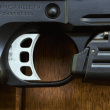
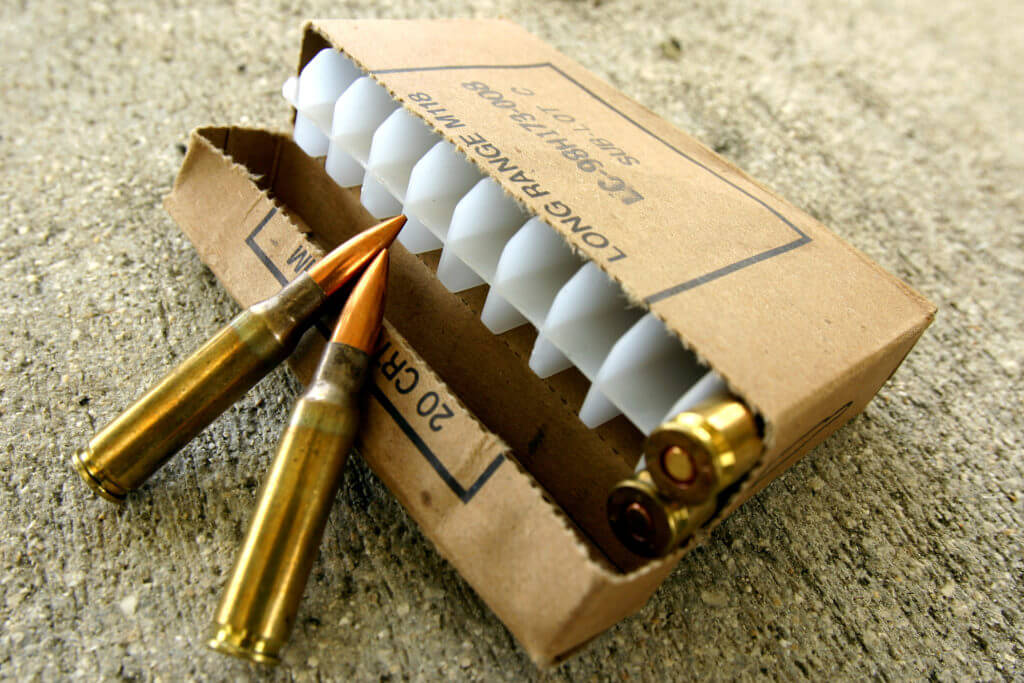
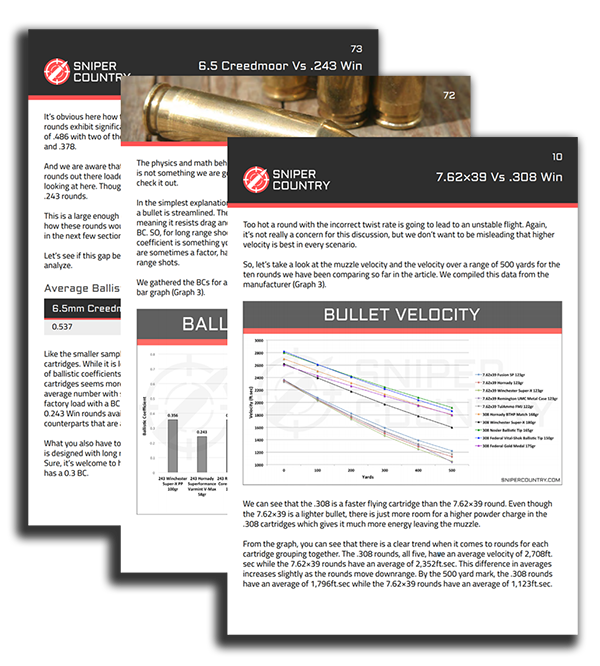

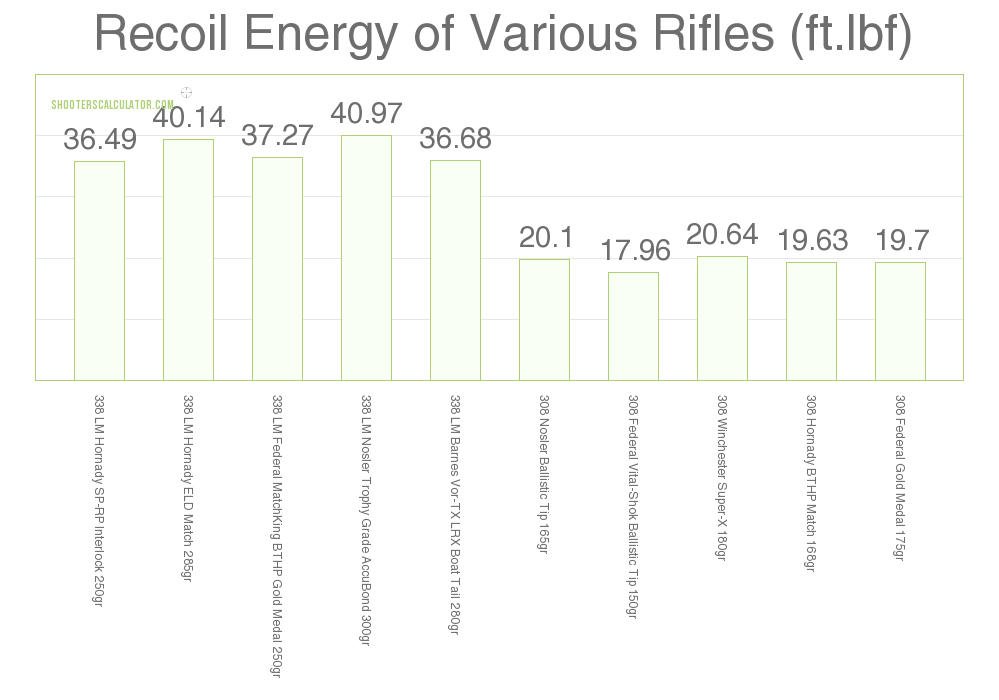
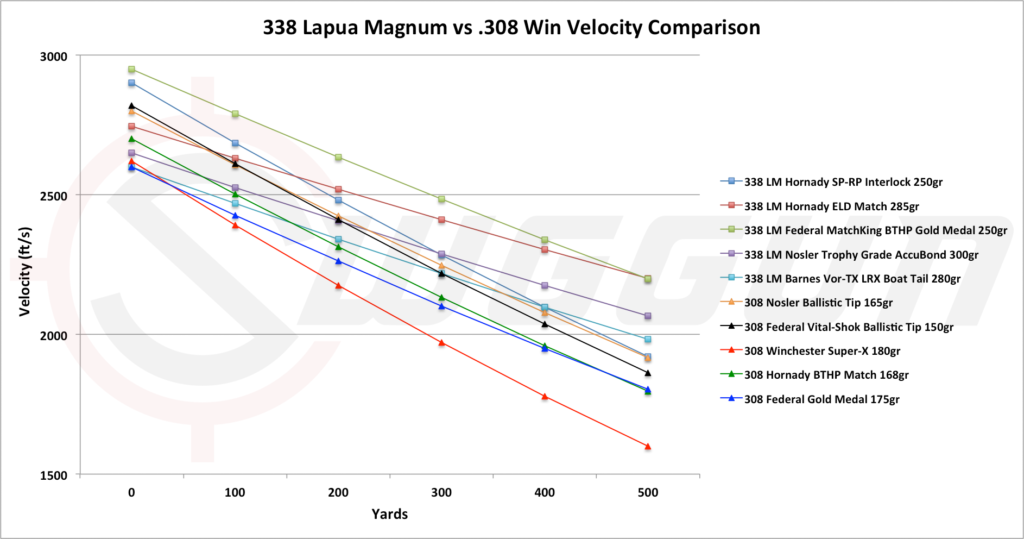
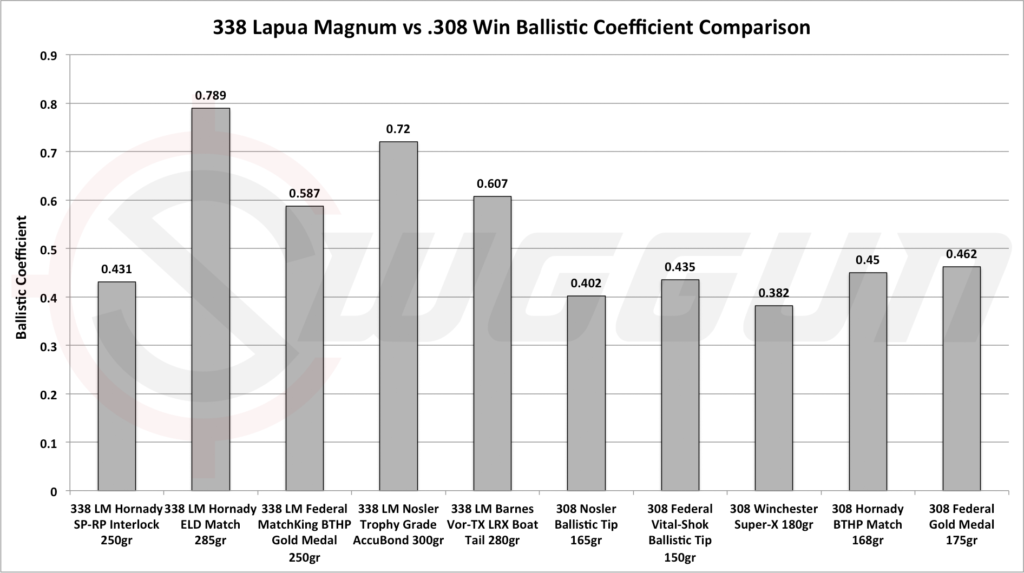
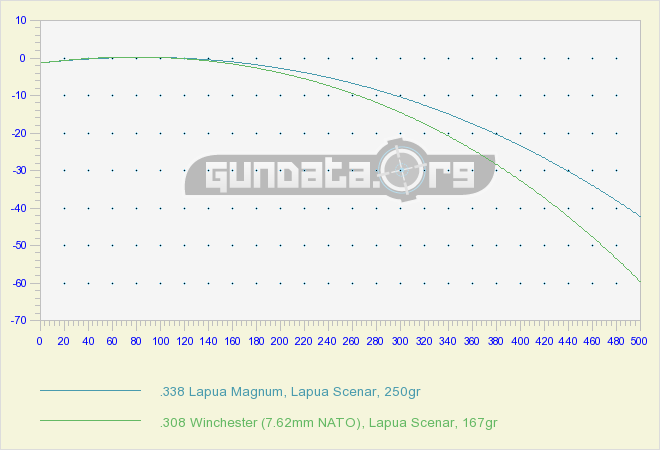
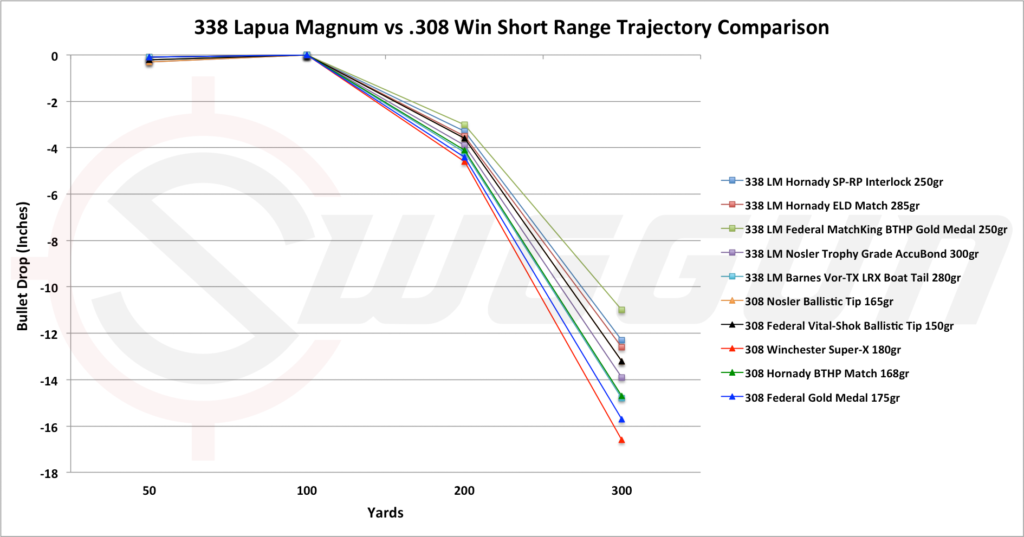
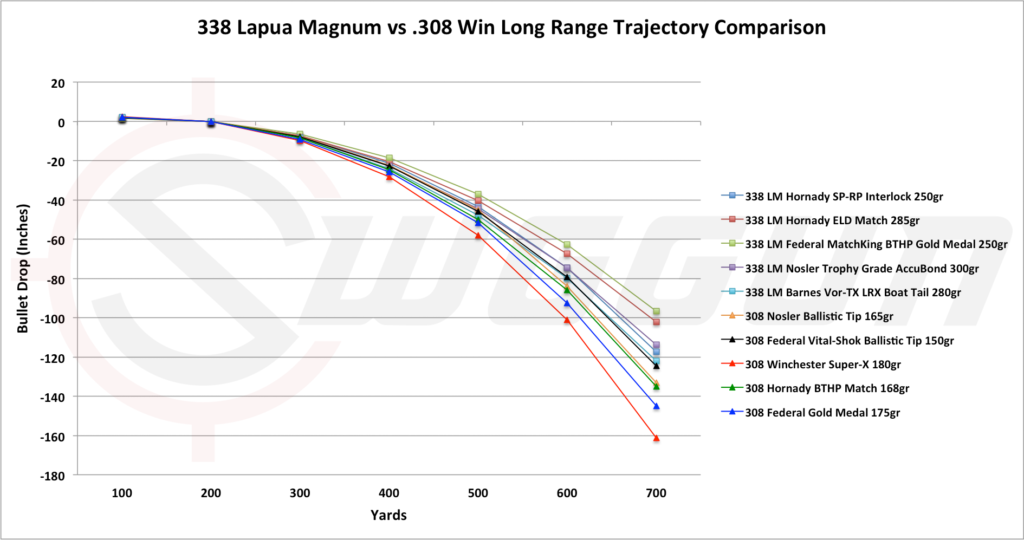
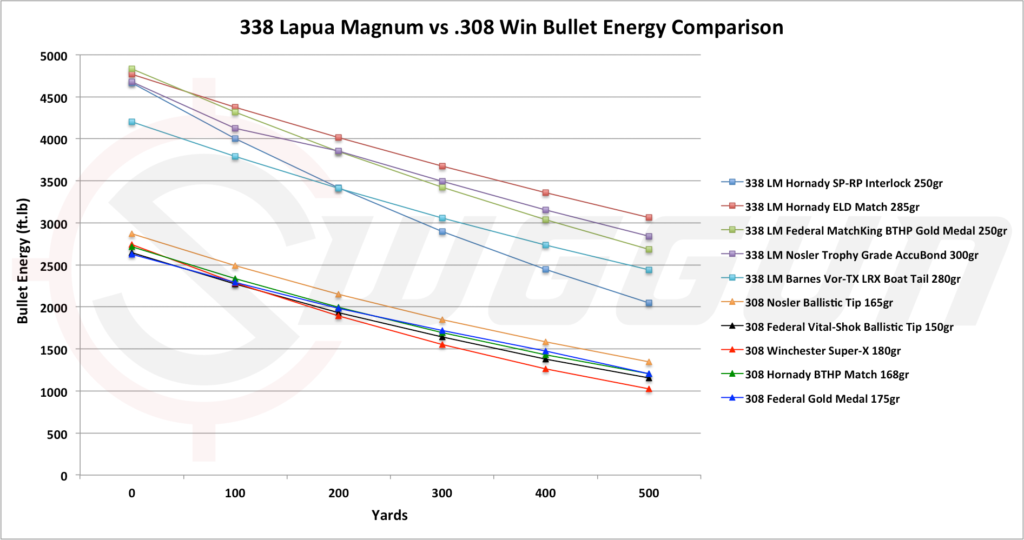
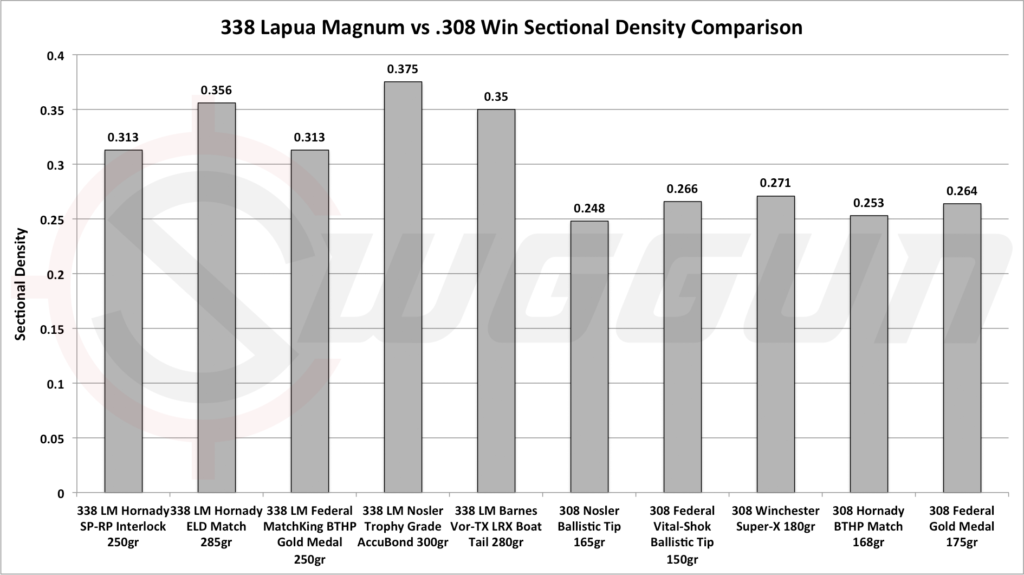

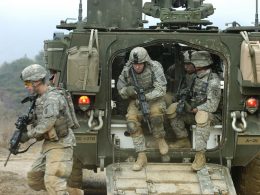

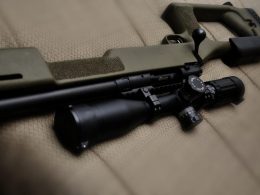
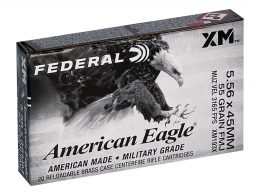
All that aside, the real skill is with the person behind it.
Just a different application
223 for 0-500
308 for 500-1000
338 1000+
Shooting a 150yrd target with a 338 makes about as much sense as taking a 1200yrd shot with a 223
Excellent break down of both calibers. Thank you for a very interesting article. Think I’ll stick with the .308.
Thanks, nice comparison.
Already own a .303 (a real hunting rifle!) and .308, and recently purchased a .338. Why, because I can, and it is all about having fun!